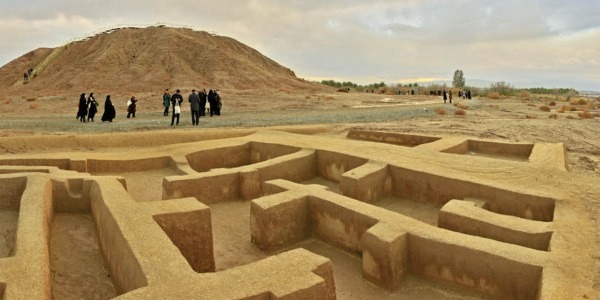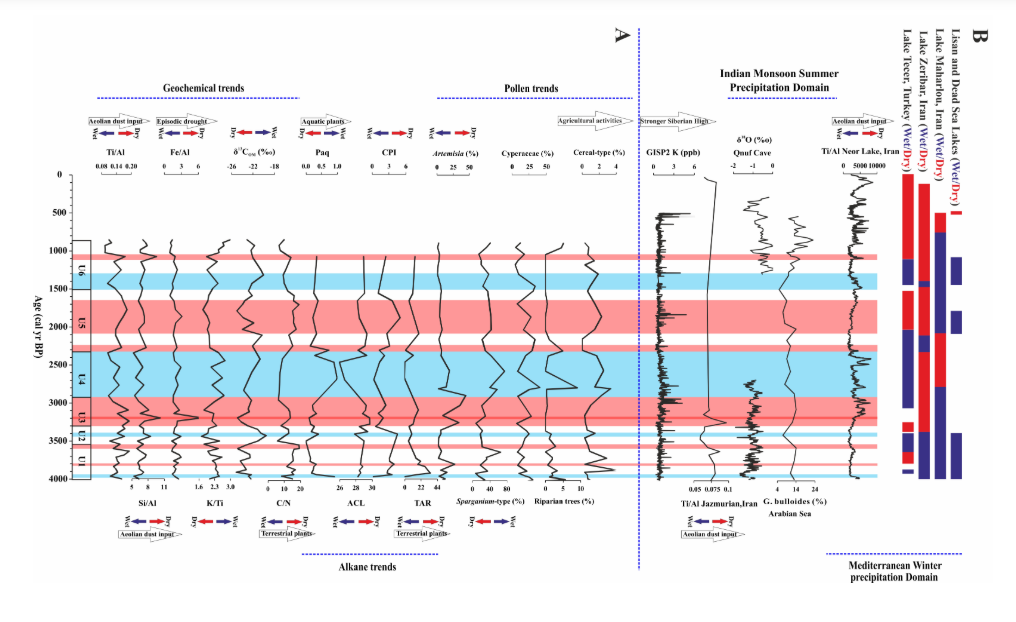

Revealing ancient environmental and climatic changes in the ancient site of Jiroft from the past four thousand years to the present using modern applied technologies
Revealing the ancient environmental and climatic changes of the Jiroft archaeological site over the past four thousand years using
new applied technologies
Project leader: Dr. Alireza Vaezi
Client: Geological and Mineral Exploration Organization of the country
Year: 1402
The ancient location of Jiroft is located between two semi-arid climates in the north and arid in the south, which makes the aquatic and terrestrial ecosystems highly sensitive to the consequences of climate change in this region. Based on archaeological excavations, the Halil Rud cultural area generally enjoyed prosperity during the third millennium. This civilization was suddenly abandoned in the late third millennium BC and then flourished again in the first millennium BC. A combination of unique phytogeographic, climatic, and archaeological features has made Jiroft a very suitable location for studying paleoclimatic changes and human-environment interactions (Vaezi et al., 2022).
In order to reconstruct the paleoenvironmental and climatic changes of the ancient Jiroft region in southeastern Iran over the past 4000 years, the present study examined multiple sedimentological, biogeochemical (biomarkers, isotopes, and elements) and pollinological evidence on a two and a half meter sediment core recovered from a peat bog near the ancient site 25 km south of Jiroft city. The sediment core covers the time period from 4011 to 854 years before present and provides a unique climate record from southeastern Iran, helping us to reconstruct past climate changes and their spatiotemporal impact on the Iranian Plateau.
Results from various climate markers indicate that Jiroft has experienced environmental changes due to natural and anthropogenic pressures over the past 4000 years. In the late Holocene, the region was characterized by Saharan-Sindhi-like savannah vegetation. However, the landscape has changed from sparse shrub forests to open and degraded shrublands. A large part of such transition may be related to human activities, namely burning and subsequent agro-pastoralism, which later led to soil degradation. Such evidence is strongly supported by the amount of charcoal and cereal pollen, which correspond to the reduction of woody shrub vegetation (Gurjazkaite et al., 2018).
Around 3950 years ago, low Ti/Al, Si/Al, C/N, and CPI values, along with high K/Al, δ13COM, and Paq values, indicate a humid period. Between about 3900 and 3293 years ago, a temperate climate prevailed with a significant presence of Cerealia pollen between about 3880 and 3720 years ago. Between about 3293 and 2897 years ago, Jiroft was very dry and dusty, and this dryness reached its most severe level around 3200 years ago, coinciding with the regional collapse of the Late Bronze Age civilizations in the Middle East. After this dry period, a long wet period is discernible from about 2897 to 2302 years ago, with a significant increase in Sparganium pollen and high Paq values. The highest Ti/Al values, together with the lowest δ13COM values, indicate increased wind activity and dry conditions between 2100 and 1650 years ago. Jiroft experienced wet conditions between 1540 and 1315 years ago. With a relative decrease in precipitation, a temperate climate prevailed in Jiroft between 1315 and 854 years ago.
The Jiroft sediment core revealed that the landscape at Jiroft clearly had a Saharan-Sindhi vegetation. This is supported by the continuous, although not uniform, occurrence of Prosopis pollen. This is similar to the current vegetation at Jiroft (Léonard, 1991; 1993), which includes more than 35% of the endemic Saharan-Sindhi species. Accordingly, it appears that the landscape throughout the region, during the sampling period, was an open savannah-like vegetation dominated by xerophytic shrubs and trees (Gurjazkaite et al., 2018).
Signs of agriculture and animal husbandry occur during the 4000-year record at Jiroft in the sediment core examined in this study. However, there is no strong evidence of agriculture, indicating a sedentary lifestyle of humans during the study period. Pollen of the genus Cerealia, most likely wheat or barley, is the main pollen of cultivated plants identified in Jiroft (Mashkour et al., 2013).
Cereal cultivation is detectable throughout most of the study period, but a major decline is seen from 3300 to 3000 years ago. This time period coincides with droughts indicated by various climatic markers. The second period, when evidence for cereal cultivation is not as evident, occurred just after the decline of the Achaemenid Empire (Vaezi et al., 2022). This decline in agricultural activities is also associated with drought. These results suggest a link between environmental changes and human lifestyle in Jiroft. In particular, drought played an important role in influencing agro-pastoral societies (Vaezi et al., 2022). More extensive animal husbandry is evident from about 3520 to 2150 years ago. Pollen identified during this period is most likely associated with trampling by livestock and grazing (Djamali et al., 2009b; Leroy et al., 2013). Therefore, harsh climatic conditions may explain the development of a nomadic lifestyle that has deep historical roots in the region (Zanjāni and Nejātiān, 2014).
The major period of cereal cultivation from the late Iron Age to the Islamic period occurred between 2800 and 900 years ago. Based on the results of dating of charcoal grains and domesticated animal bones, an occupation phase occurred in the northern sandalwood area between approximately 3000 and 2400 years ago (Mashkour et al., 2013). These findings strengthen the pollen evidence of the present study regarding agricultural-pastoral activities in this period in the region. In addition, many agricultural activities are mentioned in the historical periods, especially the Islamic periods, in the travelogues of Marco Polo and the chronicles of Muhammad ibn Ibrahim. These historical periods correspond to periods of increase in pastures and decline of some desert plants.
The hydrological changes of Jiroft over the past 4000 years are more consistent with similar trends in other places dominated by Mediterranean winter rainfall, such as Lake Tecer in central Turkey (Kuzucuoǧlu et al., 2011), and are better compared with records from western Iran, for example (Sharifi et al., 2015; Shumilovskikh et al., 2016). The hydrology of Jiroft seems to reflect more hydroclimatic changes related to the North Atlantic Oscillation and the Mediterranean Circulation than to changes in the Indian Ocean Monsoon (Vaezi et al., 2022). However, it is still difficult to judge the extent to which Jiroft discharge changes are influenced by changes in the Indian Ocean Monsoon and possible flash floods related to summer rainfall and associated rainstorms in the Kerman Mountains. Unfortunately, a precise comparison of our record with changes in the Indian Ocean Monsoon (IOM) system is not yet possible due to the lack of a continuous monsoon record from the region. The only existing record of summer rainfall changes related to monsoon rainfall from the region is from the Oman Sea, but there is a gap between approximately 5000 and 2300 years ago (Fleitmann et al., 2007).
 Figure 1- Comparison of paleoclimate conditions inferred based on different indices from the Jiroft peat sequence in southeastern Iran and other climate archives in West Asia (Vaezi et al., 2022). a) Selected sedimentological, geochemical, and palynological results from the Jiroft peat sequence. b) Paleoclimate data from other regions, K+ changes in the GISP2 ice core of Greenland as an indicator of changes in the intensity of the Siberian rift (Mayewski et al., 1997); Ti/Al changes in the Jazmorian playa, southeastern Iran (Vaezi et al., 2019); Changes in the intensity of the Indian Ocean summer monsoon indicated by δ18O in stalagmites of Qunf Cave, Oman (Fleitmann et al., 2003); Globigerina abundance at ODP station 723, Arabian Sea (Gupta et al., 2003); Changes in Ti concentration in peatland around Lake Neor in northwestern Iran under the influence of Mediterranean winter precipitation (Sharifi et al., 2015). Some important paleoclimatic records of Mesopotamia and the Mediterranean (Djamali et al., 2010; Kuzucuoglu et al., 2011; Migowski et al., 2006; Stevens et al., 2008). Red and blue bars indicate dry and wet periods.
Figure 1- Comparison of paleoclimate conditions inferred based on different indices from the Jiroft peat sequence in southeastern Iran and other climate archives in West Asia (Vaezi et al., 2022). a) Selected sedimentological, geochemical, and palynological results from the Jiroft peat sequence. b) Paleoclimate data from other regions, K+ changes in the GISP2 ice core of Greenland as an indicator of changes in the intensity of the Siberian rift (Mayewski et al., 1997); Ti/Al changes in the Jazmorian playa, southeastern Iran (Vaezi et al., 2019); Changes in the intensity of the Indian Ocean summer monsoon indicated by δ18O in stalagmites of Qunf Cave, Oman (Fleitmann et al., 2003); Globigerina abundance at ODP station 723, Arabian Sea (Gupta et al., 2003); Changes in Ti concentration in peatland around Lake Neor in northwestern Iran under the influence of Mediterranean winter precipitation (Sharifi et al., 2015). Some important paleoclimatic records of Mesopotamia and the Mediterranean (Djamali et al., 2010; Kuzucuoglu et al., 2011; Migowski et al., 2006; Stevens et al., 2008). Red and blue bars indicate dry and wet periods.
ارسال نظر برای این محصول مجاز نیست.
